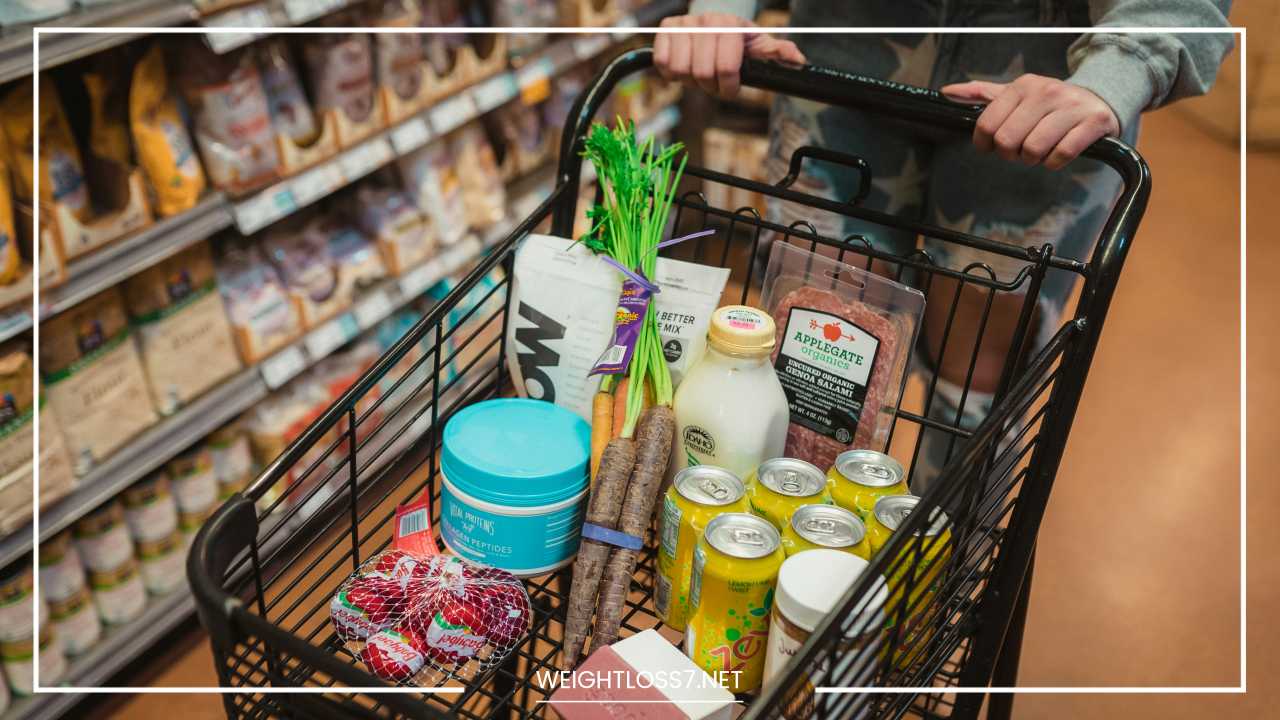Shop Healthy: Eat Well on a Budget

Shop Healthy
Shop Healthy: Your Ultimate Guide to Making Smart Choices at the Grocery Store
Conquering the grocery store and making healthy choices can feel like navigating a maze. But fret no more! This comprehensive guide will equip you with the knowledge and strategies to transform your shopping trips into triumphs for your health and taste buds.
We’ll delve into meal planning, deciphering food labels, navigating the grocery store like a pro, keeping healthy eating affordable, and exploring alternative shopping options. By the end, you’ll be a confident shopper, ready to stock your pantry with nutritious goodies.
Planning Your Meals for Success
Before the grocery store beckons, take some time to chart your course for the week. Meal planning is your secret weapon against impulse buys and wasted food. Here’s how to get the most out of it:
- Know Yourself, Know Your Needs: Consider any allergies, intolerances, or dietary preferences you have. Are you vegetarian, vegan, or following a specific plan like paleo or keto? Cater your meal plan accordingly.
- Embrace Reality: Be honest about your schedule. How much time can you realistically dedicate to cooking each day? Prioritize quick and easy meals for busy weekdays, leaving more elaborate dishes for weekends when you have more time.
- Seasonal Symphony: Seasonal produce is a symphony for your taste buds and wallet. Research what’s in season in your area and incorporate those vibrant fruits and vegetables into your meals. They’ll be at their peak flavor and affordability.
- The Power of Leftovers: Don’t underestimate the magic of leftovers! Plan meals that can be easily repurposed into lunches or another dinner. Leftovers are a lifesaver on busy days and help reduce food waste.
Mastering the Grocery Store: A Shopper’s Odyssey
Now, armed with your meal plan, it’s time to embark on your grocery store odyssey. Here are some battle-tested strategies to help you make informed and healthy choices:
- The Perimeter Principle: The outer aisles of the grocery store are your haven. This is where you’ll find fresh produce, the foundation of a healthy diet. Meat, dairy, and the bakery section often reside here as well. Prioritize these areas over the inner aisles, which are typically stocked with processed foods.
- Decoding the Food Label: Don’t be intimidated by those seemingly cryptic food labels! They’re actually your allies in making informed choices. Learn how to read them effectively. Pay close attention to serving sizes, calories, fat (especially saturated and trans fats), sugar (including added sugars), sodium, and fiber content.
- Marketing Mysteries: Be wary of marketing claims. Words like “healthy,” “natural,” or “low-fat” don’t always guarantee a healthy choice. Dig deeper and scrutinize the ingredients list to see what’s truly in the product.
- Whole Grains for the Win: Ditch refined grains and embrace whole grains! They’re a powerhouse of fiber, keeping you feeling fuller for longer and aiding digestion. Swap white bread, rice, and pasta for their whole-wheat counterparts. Explore options like quinoa and barley for added variety.
- Lean Protein Powerhouse: Protein is crucial for building and maintaining muscle mass. Make lean protein sources a staple in your meals. Think skinless chicken breasts, fish, lean cuts of beef, beans, lentils, and tofu.
- The Magic of Healthy Fats: Don’t be afraid of healthy fats! They’re essential for a balanced diet. Include sources like avocado, nuts, seeds, and olive oil in your meals. They’ll not only enhance flavor but also keep you feeling satisfied.
- Frozen: Nature’s Helping Hand: Frozen fruits and vegetables are a fantastic option when fresh produce isn’t readily available or affordable. The flash-freezing process captures them at peak ripeness, so they retain most of their valuable nutrients. Stock up on frozen options to ensure you always have healthy choices on hand.
- Pantry Staples: Your Culinary Safety Net: Having a well-stocked pantry with healthy staples like canned beans, whole-grain pasta, oatmeal, canned tomatoes, and dried herbs can be a lifesaver. These versatile ingredients allow you to whip up quick and easy meals when time is tight.
Healthy Eating on a Budget: Making Smart Choices with Your Wallet
Eating healthy doesn’t have to drain your bank account. Here are some clever strategies to shop healthy on a budget:
- The List is Your Lifeline: Make a detailed grocery list based on your meal plan and stick to it religiously. This will curb impulse purchases and ensure you only buy what you truly need.
- Bulk Up (Smartly): Buying certain staples like rice, beans, nuts, and oats in bulk can save you money in the long run. However, be honest with yourself. Only buy in bulk if you know you’ll use everything before it expires. Buying a giant bag of almonds is a great deal, unless half ends up going stale because you can’t finish it in time.
- Discount Grocery Detectives: Discount grocery stores are treasure troves for budget-conscious shoppers. They often offer lower prices on both name-brand and generic items. Explore these stores and compare prices to find the best deals.
- Couponing Can Be Cool: Don’t scoff at coupons! Many grocery stores offer weekly sales and coupons. Newspapers, store apps, and websites are great resources for finding coupons. Clip them, download them, and use them strategically to lower your grocery bill.
- Generic Gems: Store-brand products shouldn’t be overlooked. Often, they’re just as good as name brands but at a fraction of the cost. Compare ingredients lists and give generic options a try. You might be surprised at the quality and savings.
- Seasonal Savings: Remember our friend, seasonal produce? It’s not just good for your taste buds and health, it’s budget-friendly too! Out-of-season fruits and vegetables are often more expensive due to transportation and storage costs. Embrace what’s in season and reap the financial rewards.
- Waste Not, Want Not: Food waste is a major budget drain. Plan your meals carefully and only buy what you need. Learn proper storage techniques to extend the shelf life of your groceries. Utilize leftovers creatively and avoid letting perfectly good food go to waste.
Healthy Shopping Beyond the Grocery Store
The grocery store isn’t the only place to find healthy food options. Here are some additional tips to expand your healthy shopping horizons:
- Farmer’s Market Frenzy: Farmer’s markets are a vibrant hub of fresh, locally-grown produce, often at competitive prices. You’ll find unique varieties and support local farmers by shopping there. Immerse yourself in the sights, sounds, and fresh bounty of a farmer’s market.
- Community Supported Agriculture (CSA): Consider joining a CSA program. CSAs connect you directly with local farms. You pay a subscription fee in advance and receive a weekly or bi-weekly box of fresh, seasonal produce. It’s a convenient way to get a variety of high-quality fruits and vegetables while supporting local agriculture.
- The Convenience of Online Grocery Shopping: Online grocery shopping can be a time-saving option. It allows you to browse from the comfort of your home, avoid impulse purchases by sticking to your list, and potentially schedule delivery for a convenient time. However, be mindful of delivery fees that can add to your costs. Compare online prices with in-store prices to see if it makes sense for your budget.
Building a Healthy Shopping Habit
Making healthy shopping a habit takes time and practice. Be patient with yourself, celebrate your victories, and don’t get discouraged by setbacks.
Utilize the tips in this guide, personalize them to your preferences, and most importantly, have fun exploring the world of healthy eating! Here are some additional thoughts to solidify your healthy shopping journey:
- Involve the Family: Get your family involved in the meal planning and grocery shopping process. This can be a fun and educational experience for everyone. Delegate tasks based on age and ability. Let your kids help choose fruits and vegetables, or assign them the responsibility of comparing prices on certain items.
- Embrace New Flavors: Don’t be afraid to experiment with new fruits, vegetables, and whole grains. You might discover a hidden gem that becomes a new favorite. Explore ethnic grocery stores or sections in your supermarket to find inspiration and expand your culinary horizons.
- Learn to Cook: Cooking at home is a powerful way to control your health and diet. Invest in a good cookbook or find reliable online recipes. Start with simple meals and gradually build your skills. The more comfortable you become in the kitchen, the more likely you are to stick to healthy eating habits.
- Celebrate Your Successes: Acknowledge and celebrate your progress. Did you conquer the grocery store without buying any sugary snacks? Did you try a new recipe that turned out delicious? Give yourself a pat on the back for these victories!
Remember, a healthy lifestyle is a journey, not a destination. By incorporating these tips and strategies, you’ll be well on your way to becoming a confident, healthy shopper, equipped to navigate the grocery store with ease and fill your plate with nutritious and delicious food. Happy shopping!
Beyond the Basics: Advanced Strategies for the Savvy Shopper
Once you’ve mastered the grocery store fundamentals, you can delve deeper and explore some advanced strategies to further optimize your healthy shopping experience:
- Understanding Unit Pricing: Unit pricing, often displayed in tiny text on the shelf below the product, reveals the true cost per unit (ounce, pound, gram) of an item. This allows you to compare different brands and sizes more effectively. For example, a large package of cereal might seem like a bargain at first glance, but when you compare the unit price to a smaller box, you might discover the smaller box is actually the better deal.
- Beware of Hidden Sugars: Sugar lurks in many unexpected places, not just candy and desserts. Pay close attention to the ingredients list and added sugars content. Look for terms like “high fructose corn syrup,” “cane sugar,” “brown sugar,” and “honey.” These all contribute to your total sugar intake.
- Decoding Food Labels for Specific Needs: If you have specific dietary needs, like managing diabetes or following a gluten-free diet, learn how to interpret food labels accordingly. Look for labels that indicate sugar content per serving, fiber content, and the presence of gluten. Many products also have certifications for specific dietary needs, such as gluten-free or vegan. Familiarize yourself with these symbols to make informed choices.
- Apps for the Win: Several smartphone apps can be valuable tools for healthy shopping. Use apps to create and manage your grocery list, compare prices at different stores, find healthy recipes based on ingredients you have on hand, and track your nutritional intake. Explore the options and find apps that complement your shopping style.
- Planning for Special Occasions: Temptation often intensifies during holidays and special occasions. Plan ahead and stock up on healthy snacks and party foods. Prepare healthy alternatives to traditional party fare, or offer smaller portions of indulgent treats. This will help you avoid unhealthy impulse buys when faced with a tempting dessert table.
Sustainable Shopping: Good for You, Good for the Planet
Healthy eating and environmental responsibility go hand in hand. Here are some tips to incorporate sustainable practices into your shopping routine:
- Reduce Food Waste: As mentioned earlier, food waste is a major concern. Plan your meals carefully, buy only what you need, and learn proper storage techniques to extend the shelf life of your groceries.
- Choose Sustainable Seafood: When buying seafood, opt for varieties labeled as “sustainable” by reputable organizations like the Marine Stewardship Council (MSC). This helps ensure you’re supporting healthy fish populations and responsible fishing practices.
- Reduce Packaging: Consider buying items with minimal packaging, or choose products packaged in recyclable materials. Opt for loose fruits and vegetables instead of pre-packaged options whenever possible. Bring your own reusable shopping bags to further reduce waste.
- Shop Local: Supporting local farmers markets and farms not only provides you with fresh, seasonal produce, but it also reduces the environmental impact associated with long-distance transportation.
Final Word: Empowered and Equipped for Healthy Shopping
By equipping yourself with knowledge, planning your meals, and utilizing the strategies outlined in this guide, you’ll be well on your way to becoming a confident and empowered healthy shopper.
Remember, healthy shopping doesn’t have to be complicated or expensive. With a little planning and effort, you can navigate the grocery store aisles with ease, make informed choices that benefit your health and well-being, and embrace a sustainable shopping approach that’s good for you and the planet. Happy shopping, and happy eating!

















